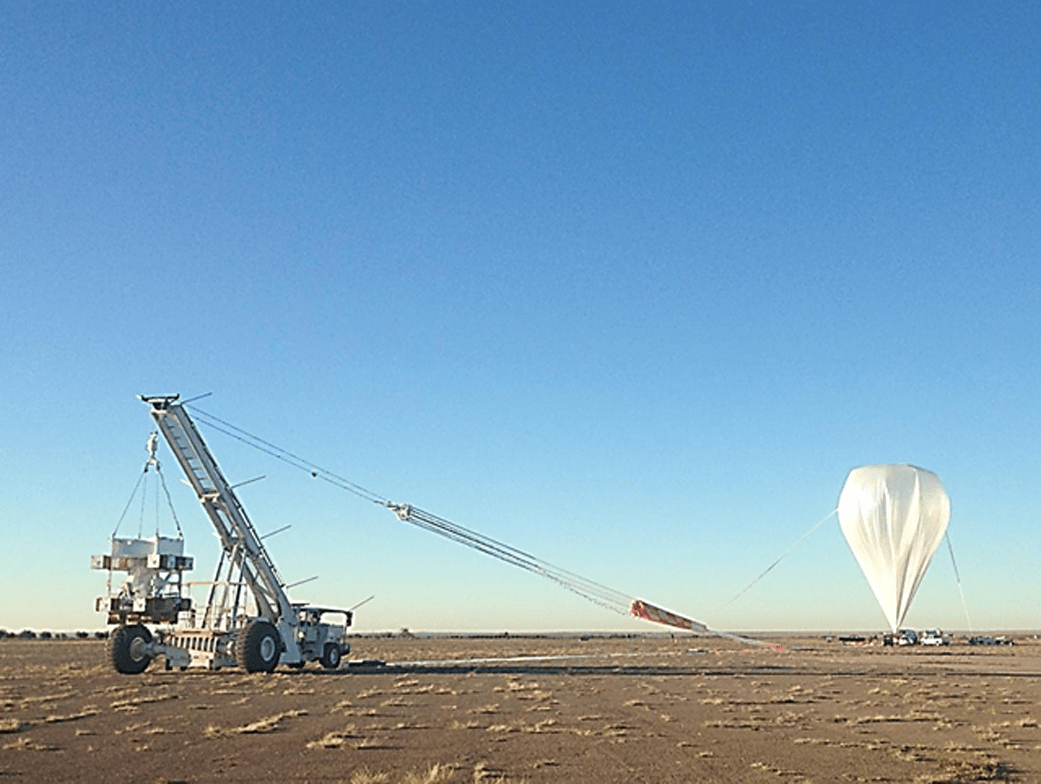
Seven of eight scientific balloon missions have launched from Fort Sumner, New Mexico, since the fall balloon campaign began Aug. 9, and preparations are underway for the final mission.
The remaining mission pairs the Wallops-built Wallops Arc-Second Pointer (WASP), capable of highly precise pointing to the sub-arc-second level, with the Observatory for Planetary Investigations form the Stratosphere (OPIS) instrument, built at Goddard Spaceflight Center’s Greenbelt campus.
“High-altitude balloons offer us a unique, low-cost platform to carry out our planetary observations,” said Terry Hurford, principal investigator for OPIS, during an interview earlier in 2014. WASP/OPIS “provides us with a unique opportunity to build a capability that we can leverage for future opportunities.”
The WASP/OPIS team was flight ready as of press time, however weather—including an intense hailstorm with whiteout, high winds, and horizontally-blown hailstones at least 0.5 inches in diameter—continues to be a challenge. The campaign window extends until about Oct. 15.
At the onset of the campaign, the balloon team knew 2014 was a strong El Niño year and the weather could be dynamic. After a week of preparations and another week of rough weather, the campaign began Aug. 9 with the successful launch of the High Altitude Student Platform 2014 (HASP 2014), the ninth in the series of the collaborative efforts between the Louisiana State University/Dr. Greg Guzik, the NASA Balloon Program Office (BPO), and the Columbia Scientific Balloon Facility (CSBF).
The flight of HASP 2014 carried payloads from nine educational institutions a flight time of 8 hours, 40 minutes to an altitude of 124,400 ft., exceeding all pre-flight objectives.
The next mission was the Aug. 18 launch of WASP with the Hyper-Spectral Imager for Climate Science (WASP/HySICS) for the Laboratory for Atmospheric and Space Physics, University of Colorado, Boulder. The HySICS instrument is improving radiometric accuracy of Earth spectral observations for climate measurements. The WASP and HySICS science teams reported excellent instrument performance and successful collection of very high quality science data after the 8 hour, 54 minute flight to an altitude of 122,100 ft.
After a number of challenging weather days, the team successfully launched the Long-Duration Balloon (LDB) Systems Test flight to test and validate the functionality of a new balloon cap design, a new high-gain antenna, and a new solar power system using a rechargeable lithium-ion battery pack. There were also two payloads of opportunity on the flight, along with two student payloads.
The launch occurred Aug. 24, achieving with a mission duration of 6 hours, 38 minutes flying to an altitude of about 123,000 ft.
Multiple attempts to launch the Jet Propulsion Laboratory (JPL) Remote mission were thwarted by weather, delaying launch to Sept. 14. The JPL Remote mission measured profiles of over 40 chemical species throughout the stratosphere to improve understanding of stratospheric chemistry and ozone layer stability and provide validation for the NASA Earth-Observing System Aura satellite. The 23 hour, 14 minute flight at about 126,000 ft. was an operations and science success.
The following week was a banner week for the campaign. The launch team in Fort Sumner took full advantage of the break in the weather and conducted three successful major launches in successive days Sept. 24-16: a first for the balloon program.
Sept. 24, the X-CALIBUR mission from Washington University in Saint Louis launched to flight-test a pointing system and hard X-ray polarimeter for a future long-duration balloon flight. With a mission duration of 7 hours, 40 minutes at about 126,000 ft., the mission was a success with the detector functioning properly and the team gaining valuable experience with operating the pointing system.
Sept. 25, the Balloon Observation Platform for Planetary Science (BOPPS) from the Johns Hopkins Applied Physics Laboratory soared for 18 hours, 53 minutes at altitudes as high as 128,000 ft. The science team was successful in making planned daylight and nighttime observations, as well as observing additional targets of opportunity.
Sept. 26, the Gamma-Ray Polarimeter Experiment (GRAPE) from the University of New Hampshire launched. GRAPE was designed to study the nature of gamma-ray bursts, some of the most energetic events in the universe. The 18 hour, 51 minute flight at altitudes up to 130,000 ft. allowed the science team two hours of observation of their prime objective – the Crab Nebula – and an additional 16+ hours at float before termination.
NASA’s Wallops Flight Facility manages the Agency’s scientific balloon program. For more information about the program, see: http://sites.wff.nasa.gov/code820/.


























